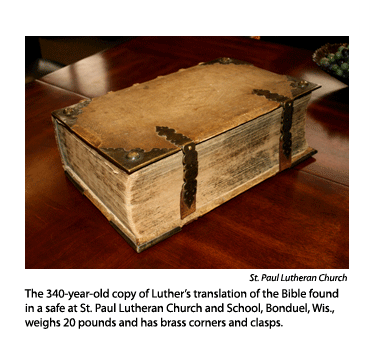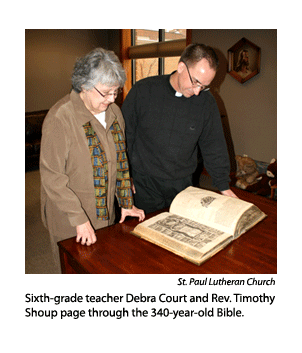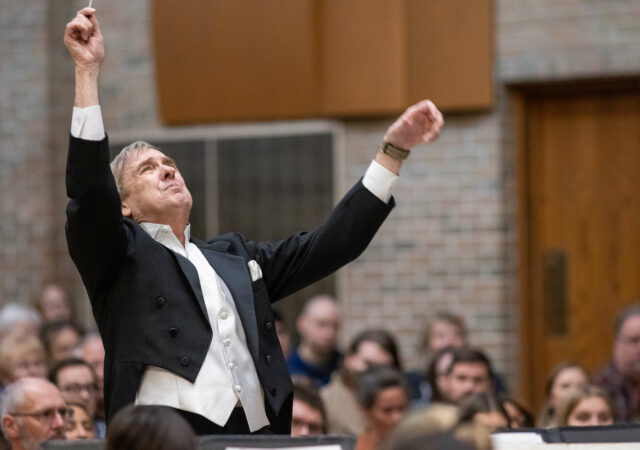By Linda C. Hoops
When Debra Court, a sixth-grade teacher at St. Paul Lutheran Church and School in Bonduel, Wis., poked around a walk-in safe at the school two years ago to look for old baptismal records to show her class, she found an undiscovered treasure gathering dust on a shelf. 
What she found was a 1,500-page copy of Martin Luther’s German translation of the Bible printed in Nuremberg, Germany, in 1670.
But Court thought it was just an old book. “It was just tucked away in the corner on a shelf,” she said. “I never would have imagined it was that old.”
After changing hands among some staff for lesson purposes, the Bible was brought to the attention of Rev. Timothy Shoup, pastor of St. Paul. “Thinking it was probably from the 1800s, I let it sit in my office for months before taking a closer look,” he said.
During that closer look, he noticed the Roman numerals MDCLXX (1670) on the front cover and decided to send images of the Bible to researchers at the library of Concordia Seminary, St. Louis.
Lyle Buettner, the library’s special collections cataloger, said only about 40 copies of Luther’s Bible are known, though it’s likely many more are undocumented. Copies of the 340-year-old Bible can be  found in various libraries in Germany and the United States, including the seminary’s. The value is believed to be between $1,000 and $1,500.
found in various libraries in Germany and the United States, including the seminary’s. The value is believed to be between $1,000 and $1,500.
The Bible is big by today’s standards — 17.5 inches long, 11.5 inches wide, 6.5 inches thick — and weighs 20 pounds. It has a pigskin binding with brass corners and clasps and contains a copy of the Augsburg Confession, the principal doctrinal statement of the theology of the Lutheran reformers as presented to Holy Roman Emperor Charles V at Augsburg, Germany, on June 25, 1530.
Describing the hand-illustrated text, Buettner said, “Each time I see an illustration like this, I just think of how beautiful it looks and how much of a labor of love it must have been for the person who actually drew it.”
Shoup told Reporter that there is a logical explanation for how the Bible came to the church. “Our founding pastor, Peter Heinrich Dicke, began his ministerial studies in Nuremberg, where the Bible was printed,” Shoup said. “We think he either brought it with him when he came to America or had it shipped over later.”
The discovery has put the town of Bonduel, some 25 miles northwest of Green Bay, on the map as the story of the Bible’s discovery has been featured on both local and national news media.
The illustrations in the Bible, created through copper etchings that served as the template for the printing process, show “incredible detail,” Shoup said. The last pages of the Bible feature a two-page spread depicting the signing of the Augs burg Confession with each person in the picture identified by a number. The following page lists the numbers and identifies the corresponding person by name.
burg Confession with each person in the picture identified by a number. The following page lists the numbers and identifies the corresponding person by name.
Shoup says the congregation hopes to keep the Bible long enough to celebrate its 150th anniversary in 2013 and possibly permanently. The church plans to create a climate-controlled display case for it.
“It would be nice to allow God’s people to enjoy this precious book for generations to come,” Shoup said. “This particular Bible is important because it marks time, how God has chosen to speak His same grace into our hearts in all times, in 2011 or in 1670, from one continent to another.”
Linda C. Hoops is a freelance writer and a member of Lutheran Church of the Resurrection, Sunset Hills, Mo.
Posted Jan. 20, 2011




